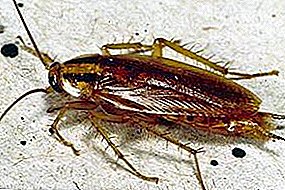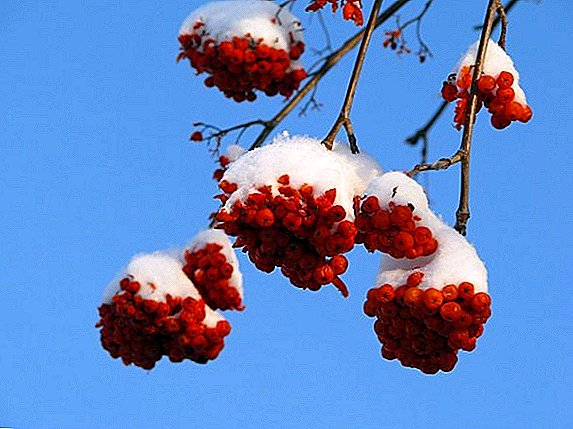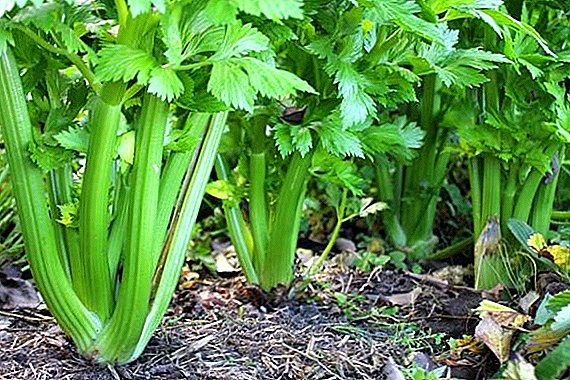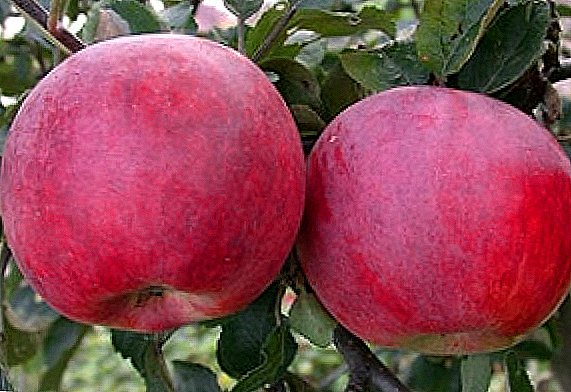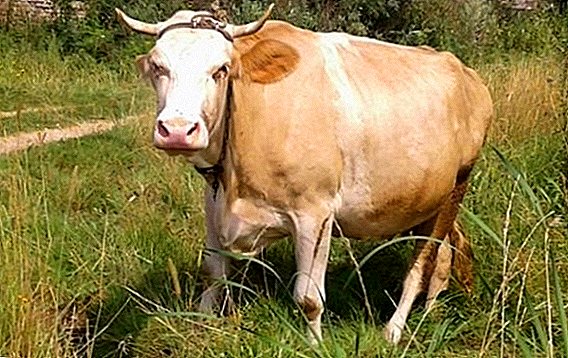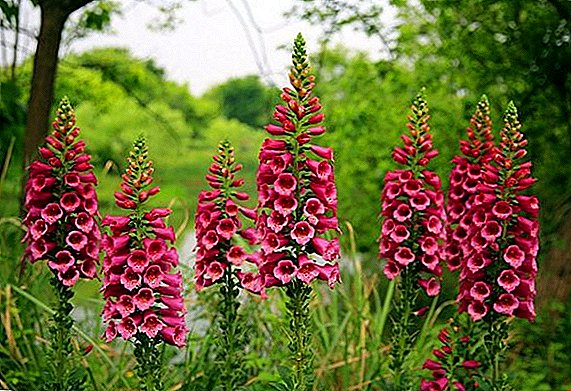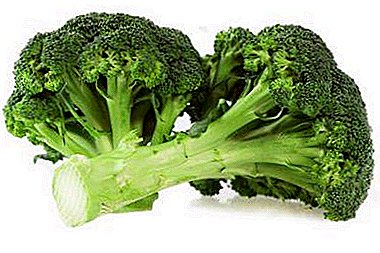
Although broccoli is not as famous as its relatives are cauliflower and white, but it is also very useful, but also has interesting taste and low calorie content. It can be used in various salads and in many other dishes.
Broccoli is an annual vegetable plant of the cabbage family. The most common variety has a dark green coaches densely collected inflorescences and thick stems. It resembles a cauliflower, but only the head has a green or purple color. Broccoli cabbage has already managed to win the hearts and attention of lovers and connoisseurs to grow edible plants at home. Consider how and when to plant broccoli, what kind of care it needs.
Features of the cultivation of vegetables
It is recommended to plant broccoli in the soil where previously carrots, onions, any cereals, legumes or potatoes.
The plant is distinguished by its simplicity, therefore, to care for him is quite simple. But despite this, broccoli is very demanding on lighting and moisture.
Features of growing broccoli:
- Where does a vegetable grow better? According to experts, the best soil for broccoli cabbage is a mixture of sod land, sand and peat. It is not recommended to use the old land from the garden, because she can be infected with her black leg and infect the plant.
- Ripening cabbage heads are better to shade from direct sunlight, otherwise they will get an unpleasant and untidy appearance. And on particularly hot days for plants it will be useful to organize the spraying of air around.
- As mentioned above, the vegetable must be well watered. But in all the necessary measure, in case of an overabundance of moisture, there is a risk of infection with a black leg and decomposition of the roots, and in case of lack - the heads of the plant will be tiny and sluggish.
It is not recommended to plant broccoli earlier than 4 years in the same places.
Differences in breeding from other members of the cabbage family
Broccoli cabbage is often confused with color, but it is different in appearance, and is considered more productive. After removing the heads in the center, a new crop is formed on the side shoots. Details about what broccoli is different from cauliflower, we told here). At the time of the formation of the heads is better to reduce the amount of water.
Broccoli also tolerates heat and cold more easily; it can be grown on any land. For the normal development of large-sized heads, you need a minimum amount of nitrogen, a sufficient amount of phosphorus and potassium, as well as good lighting. It grows in a shorter time, unlike other species, heads ripen faster.
A photo
Below in the photo you can see how broccoli is growing:



Where and for how much seed is sold?
You can also order in the center of online trade "Regmarkets", where a large assortment of any choice, both in terms of price and in terms of the manufacturer. If the purchase is planned in a regular store, as an option, you can look at the addresses on the search and select the appropriate nearby.
Comparison of seeds of different varieties
There are early ripe varieties of broccoli cabbage, and there are hybrids obtained by merging key varieties. Seeds of an early ripe grade are suitable for landing next year. The downside is that these varieties are not very fruitful and not suitable for long-term storage.
Broccoli hybrids are not suitable for planting the next crop.. But, almost not damaged by pests. In comparison with the early ripening, it is much more fruitful. Fruit formation occurs earlier, and they can be stored longer.
| Sort | Growing medium | Maturation (days) | Mass (gr) | Productivity (kg) | Specifications |
| Batavia F1 | Open ground and greenhouse | 95-102 | 0, 6-2 | 2,6 | Carry freight |
| Varus | Greenhouse | 65-75 | 0,2-0,3 | 2,9 | Resistance to adverse temperatures |
| Curly head | Open ground and greenhouse | 80-95 | 0,5-0,6 | 2,4-3,6 | Disease resistance |
| Stromboli F1 | Open ground and greenhouse | 65-70 | 1 | 2,5-3 | Resistance to bacteriosis |
| Young's F1 | Open ground and greenhouse | 60-65 | 0,2 | 1,3 | High content of β-carotene and vitamin C |
How to choose the best?
Growing broccoli from seed begins in the first half of March - it is then that broccoli seeds are sown on seedlings.
 It is possible to sow broccoli cabbage seeds in a conveyor way, in several terms every two weeks until mid-June, but since the end of April the broccoli has been planted in a seedless way directly into the ground.
It is possible to sow broccoli cabbage seeds in a conveyor way, in several terms every two weeks until mid-June, but since the end of April the broccoli has been planted in a seedless way directly into the ground.
There are many varieties and hybrids of broccoli cabbage, but which ones are the best? You can choose suitable ones according to 2 important aspects.:
- Pay attention to the period of ripening varieties. Hybrids come to the stage of readiness for 50 days, the late time of ripening is 140 or more days. Therefore, it is strongly recommended to stop the selection on early ripening varieties for the conditions of the short warm season.
- On the yield. From 1 square meter of planting it is possible to collect from 1 to 4 kg of fruits, and in some cases even 7 kg, depending on the quality and characteristics of the varieties.
When to plant and what does it depend on?
- If you expect to harvest in June, then you need to start sowing in the second half of March or in the first days of April.
- If the seedlings were sown in March, then it is first transplanted into a greenhouse, and then to the beds.
- April seedlings are sent immediately to the open ground.
It should be noted that the time for planting broccoli in the ground is chosen in the late afternoon, on an overcast day.
How to grow in the country - step by step instructions
Rassadny way
This method is simple in that you just need to seed the seeds. First, the largest ones are selected. Sow them approximately 35-40 days before disembarking in the open ground. They are usually planted in boxes with soil or in a greenhouse, to a depth of about 1 cm and with a distance between the holes of 2.5 cm.
Many gardeners sprinkle ashes, lime or dolomite flour before sowing to provide the necessary trace elements. And then dig it up. Use humus and mineral fertilizers. Some time before planting you should fertilize the soil with compost, in the calculation - 1 bucket per 1 square. m. The temperature of the medium in which the seeds will develop must be equal to 20 degrees. Then the temperature can be reduced to 15 degrees, stably maintaining it before landing.
It is required to water well, but not to allow an excess of moisture, because This can lead to the development of black legs. The first shoots of seeds growing in the greenhouse, make their way already after 10 days at a temperature of 10 degrees.
At a temperature of more than 10 degrees, the first shoots appear after 3-4 days. After 1.5-2 weeks, you can already see 3-4 leaves. During this period, they are seated in separate containers, or directly in the greenhouse, if the temperature allows it. The depth of the holes should be about 25 cm, and the distance between the landings should be at least 40 cm.
One way to transplant seedlings:
 to begin to prepare the bed (you must dig up the bed, then fertilize with humus, 30-40 g for each bush);
to begin to prepare the bed (you must dig up the bed, then fertilize with humus, 30-40 g for each bush);- in a few weeks to conduct liming in order to reduce the acidity of the soil;
- add compost (10 l / m²) to maintain a cool temperature;
- 10 - 15 cm plants can begin to transplant in the garden;
- water;
- dig holes 8 cm deep (soil should reach leaf level);
- it is necessary to nip off the main root a little to subsequently achieve a good root system;
- at the end pour water well.
Neutral and slightly alkaline soil is excellent. Also, the soil for sowing can be prepared as follows: mix sand with turf and peat, laying limestone on the bottom. To disinfect the soil need to perform the following steps:
- warm up the ground a couple of weeks before sowing;
- 24 hours prior to sowing, for the prevention of the black leg, water the soil with a solution of potassium permanganate.
Planting directly into the soil
Already in May, under the condition of warm weather, broccoli seeds can be planted by non-seedlings. In the same way as above, the land is processed and prepared. Should be planted in wet and fertilized soil. After the appearance of 2-3 leaves, you need to weed and thin the planting, the distance between the bushes should remain about 40 cm.
How to care for crops?
In the care of broccoli in the first place includes watering plants, every day or every other day. After irrigation procedures it is necessary to loosen the soil. You can use a spray to moisten the environment.. Urea can be used as the first top dressing; for this, 2 tablespoons are added to 1 bucket, about 15 bushes.
Further care of the plant is to:
- inspection of plants (removal of bad leaves, etc.);
- chemical treatment (for the prevention of diseases and pests);
- loosening the soil;
- watering as drying;
- extraction of affected plants;
- airing greenhouses.
Harvesting
 After 3 months, when the buds have fully matured, but have not yet opened, they cut off the central head with a part of the main stem, the length of which should be 15-20 cm.
After 3 months, when the buds have fully matured, but have not yet opened, they cut off the central head with a part of the main stem, the length of which should be 15-20 cm.
Due to the heat, if the broccoli heads do not darken, they quickly open and bloom. Therefore, it is recommended to harvest every 2-3 days, and in the period of bad weather - every 7-10 days.
The approaching harvest can be determined by decrepit inflorescences that bloom the very next day. Early collection is suitable for storage for a relatively short time (several days), while autumn is long.
Do not forget that some varieties of broccoli ripen and side shoots. Faster, they begin to form after cutting the main ones. Therefore, they can continue to care for and get large heads. When they grow up - they are also cut off.
Diseases and pests
- Bloom:
- non-compliance with planting dates (early disembarkation);
- the harvest is not on time;
- insufficient watering or lack thereof.
- Perinosporosis:
- high humidity, that is, excessive watering of plants;
- aspects of the weather that carry increased humidity.
- Fungal diseaseYou can determine it by bloom or brown spots.
- Kila - a disease that contributes to the fungus. If the plant is not removed, the infection with the fungus will spread to others.
- Black leg - as mentioned in this article, develops due to high humidity and is also a fungal disease. As a result of its development, the plant dies.
- Alternaria A sign of this disease caused by a fungus is black spots. It originates in the aftermath of heavy rains and warm weather.
- Mealy dew. It may occur in the autumn, on the leaves appears a bloom in the form of flour and stellate spots. The reason for this may be - fog or lack of precipitation in hot weather.
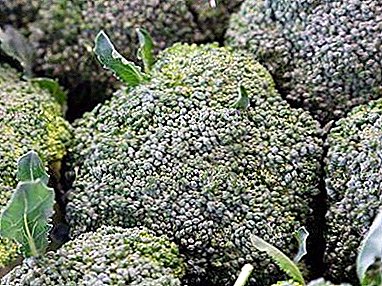 Turnip mosaic is a viral disease that spreads such a pest as aphids. Can be determined by slowing plant growth and mosaic stains.
Turnip mosaic is a viral disease that spreads such a pest as aphids. Can be determined by slowing plant growth and mosaic stains.- Mucous bacteriosis. The cause of this disease is bacteria that simply kill the plant. Signs - leaf rot, softening of the stem.
- Vascular bacteriosis is the same bacterial disease. It affects all parts of the plant. Occurs due to the following factors: moisture, persistent precipitation and pests. As a result, the vegetable dies.
- Belle is a fungal disease that damages the leaves and the aerial part. Similarly, with black ring spot.
- Fomoz. The disease manifests itself if the seed has already been infected. Light spots and black specks seize stems, roots, as well as cotyledon leaves.
In detail about the beneficial properties of broccoli, as well as contraindications to its use, read here, and from this article you will learn how this vegetable can be cooked.
Like all other vegetables and fruits, broccoli cabbage also requires timely care, although it is not particularly capricious. If you follow all the requirements of growing and care, you can have your own mini factory of broccoli cabbage at hand.


 to begin to prepare the bed (you must dig up the bed, then fertilize with humus, 30-40 g for each bush);
to begin to prepare the bed (you must dig up the bed, then fertilize with humus, 30-40 g for each bush); Turnip mosaic is a viral disease that spreads such a pest as aphids. Can be determined by slowing plant growth and mosaic stains.
Turnip mosaic is a viral disease that spreads such a pest as aphids. Can be determined by slowing plant growth and mosaic stains.